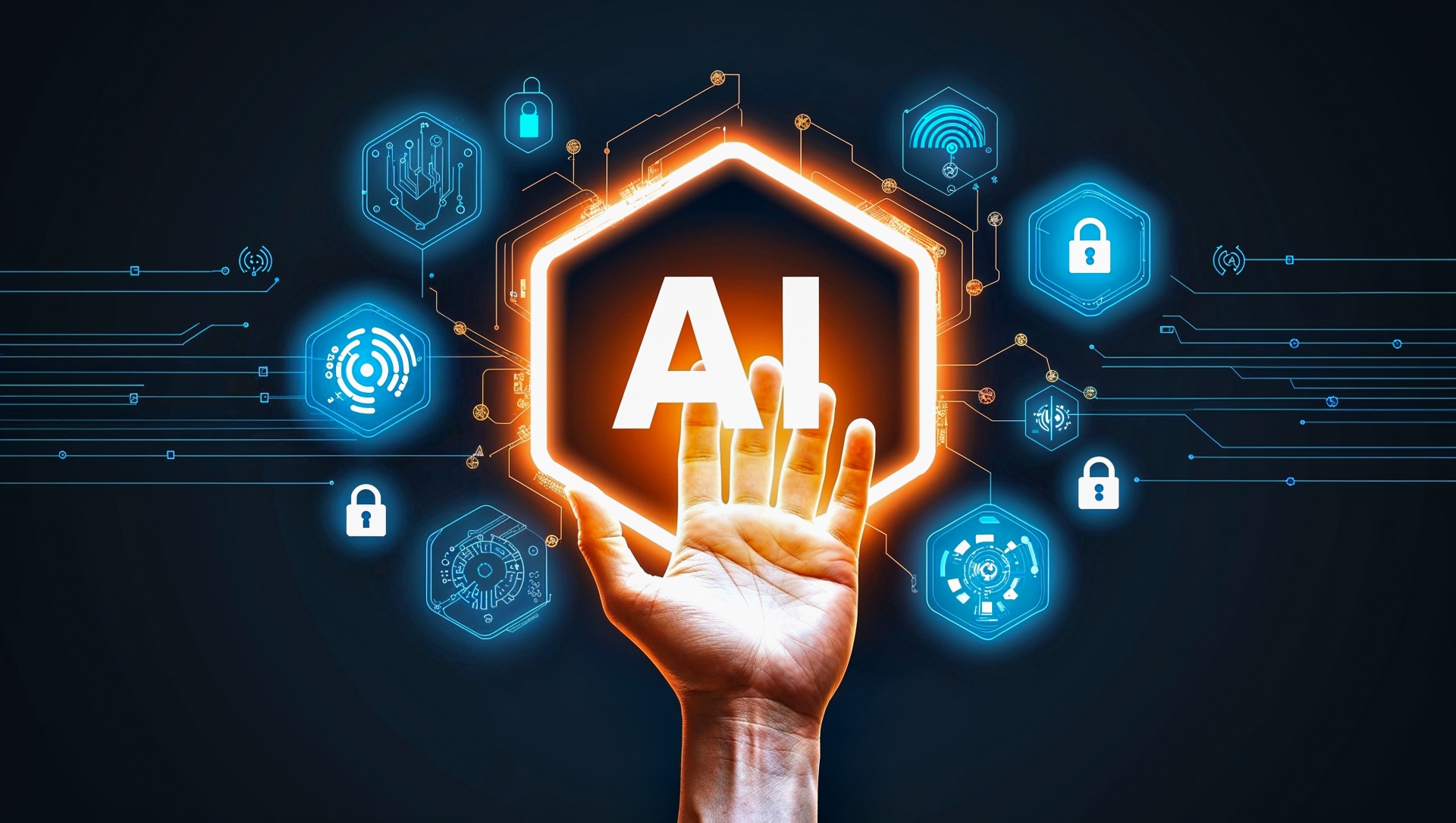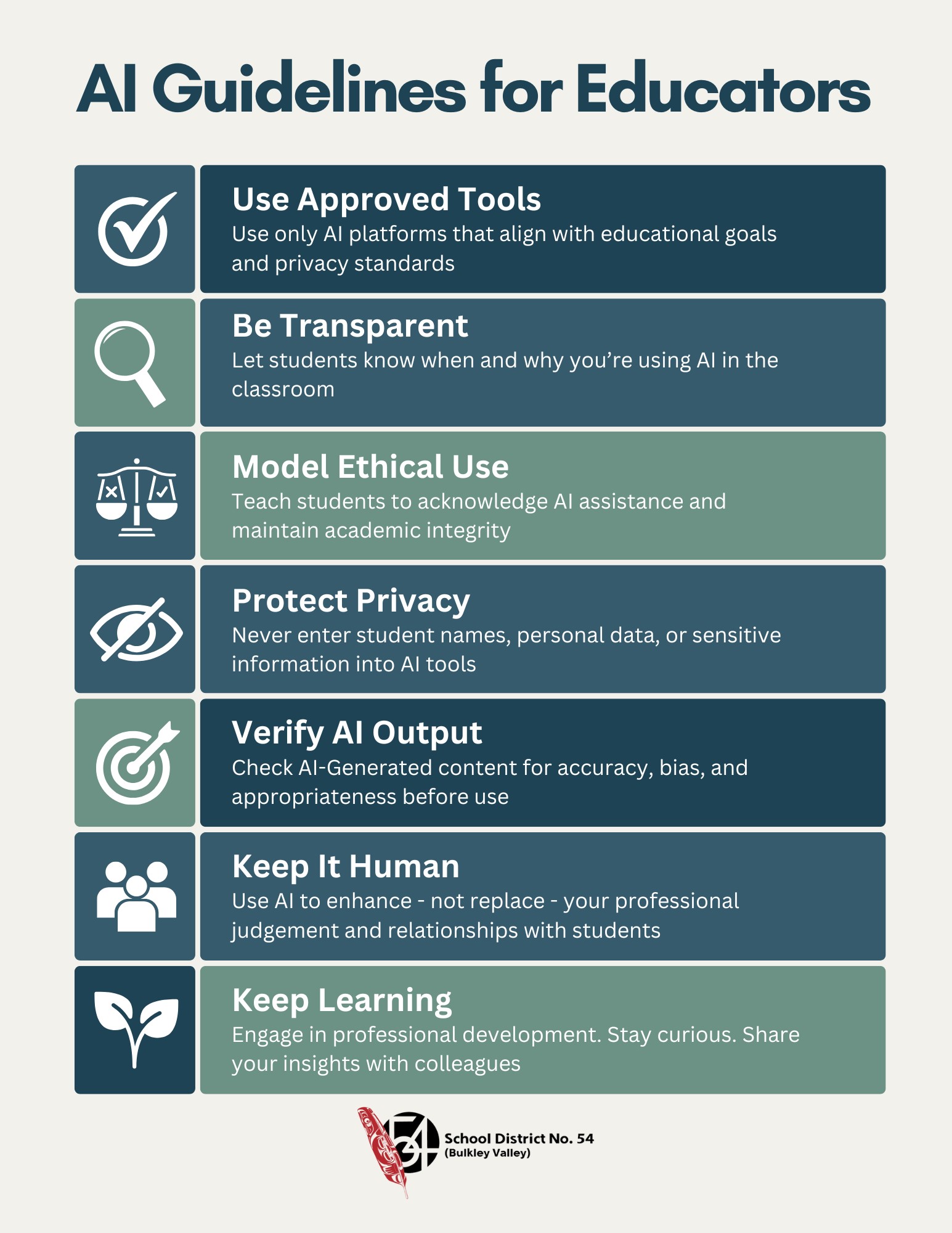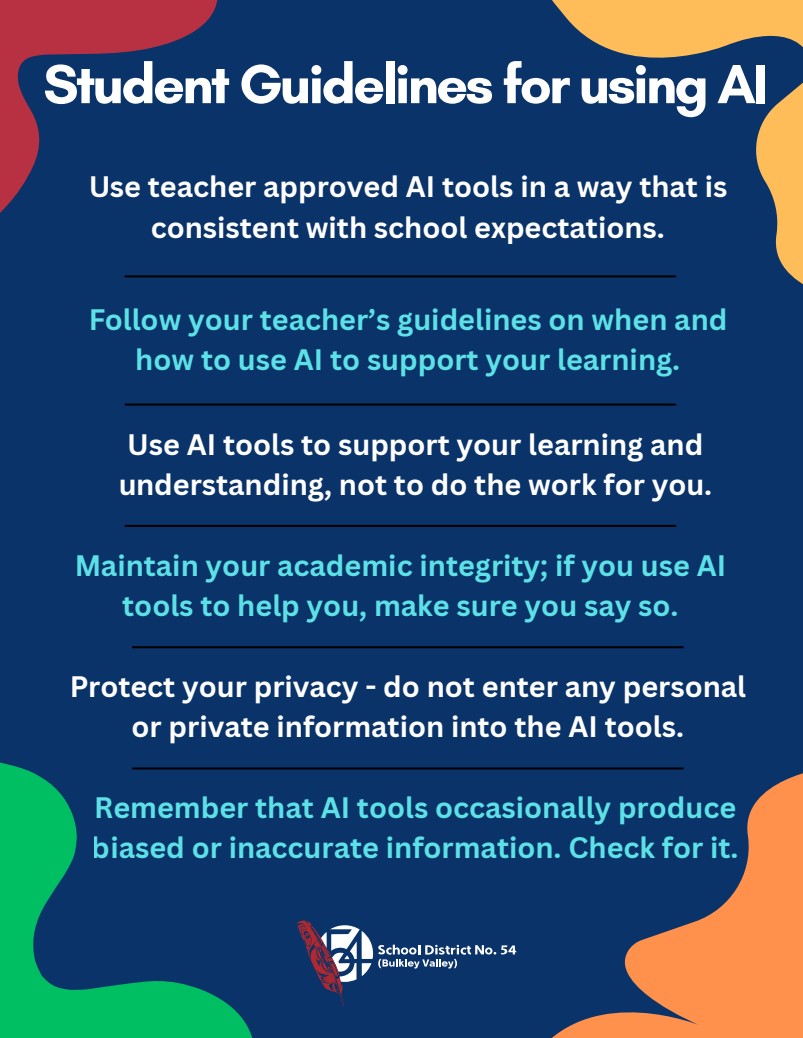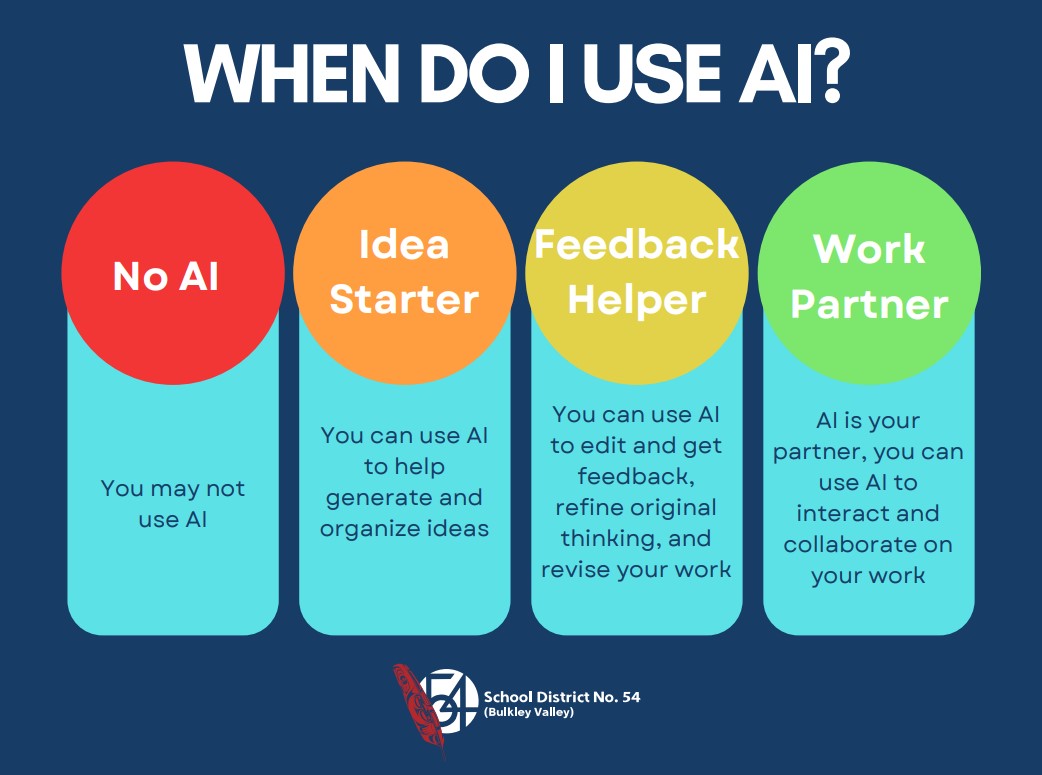AI in Schools

Preparing students for a diverse and changing world
This space is meant to help parents, caregivers, and community members understand how we’re approaching AI—carefully, transparently, and always with students’ best interests in mind.
AI is quickly changing how we live, learn, and work. In schools, it offers exciting possibilities for creativity, personalization, and efficiency—but it also brings real challenges around privacy, accuracy, and the risk of letting technology do the thinking for us.
Our focus is simple: AI should enhance learning, not replace it. We want students to understand how these tools work, when to trust them, and how to use them responsibly. Teachers are exploring ways AI can support planning and assessment, while we continue to ensure the tools we use have high educational value.


What We Are Doing
We’re moving thoughtfully—not rushing adoption. Our priorities are student well-being, privacy, equity, and learning that strengthens thinking rather than replacing it.
What this means:
-
Build staff AI literacy first (ethics, bias, assessment, effective use).
-
Teach students about AI (how it works, its limitations, when to use it, when not to).
-
Emphasizing the learning process in addition the the product of learning.
Technology is changing faster than it ever has before, and AI is no exception. As new tools and capabilities emerge, our goal is to stay responsive while keeping safety, privacy, and educational purpose at the centre. Our guidelines are designed to evolve as the technology evolves—flexible enough to adapt, but steady in their alignment with the core values and public mandate of our schools.
In School District 54, the use of AI tools is viewed through the same lens: does it support learning, protect student data, and reflect the values of equity, inclusion, and human dignity that guide all of public education?
We prioritize:
-
Protecting student privacy and personal information in line with provincial and district standards
-
Using tools that enhance teaching and learning rather than automate or replace it
-
Ensuring all students have equitable access to technology and opportunities
-
Maintaining transparency with families and staff about when AI tools are being used
Our approach is intentionally cautious. We’d rather take time to understand a tool properly than rush to adopt something that could compromise trust or learning. As AI continues to evolve, our responsibility remains the same: to make decisions that are safe, ethical, and grounded in what’s best for students.
The Student Experience
Students are encouraged to use AI as a tool to support their learning, not replace it. Appropriate uses might include brainstorming ideas, organizing outlines, refining clarity, or exploring examples to better understand a concept—always with the teacher’s permission and with clear disclosure of how AI was used. The goal is to help students think with AI, not let it think for them.
Not acceptable:
-
Submitting AI-generated work as one’s own
-
Using AI to fabricate reflections, lab data, or citations
-
Copying AI responses without understanding or personal input
-
Hiding or misrepresenting AI assistance in submitted work
Academic integrity means demonstrating authentic learning. When students use AI, they must still show their own thinking, creativity, and understanding. Teachers may ask students to share drafts, notes, or process evidence to help verify this.
What we look for in assessment:
-
Process evidence – drafts, notes, and planning that show how ideas developed over time and where AI may have played a role
-
Understanding – the student can explain their thinking, answer questions about the topic, or apply the concept in a new way (such as an oral explanation, demonstration, or reflection)
-
Original thinking – the work includes personal connections, analysis, critique, or creativity that shows the student’s voice and reasoning
Ultimately, AI can be a useful partner when used thoughtfully. Students should stay in charge of their own thinking—using AI to extend ideas, not replace them—and develop the judgment to know when to use it and when to rely on themselves.
Learning about AI fits most naturally within the Applied Design, Skills, and Technologies (ADST) curriculum, which encourages students to explore how technologies are designed, used, and improved. ADST already emphasizes critical and creative thinking, ethical use, and problem-solving—all skills that align closely with understanding and using AI responsibly.
But AI learning doesn’t stop there. It connects meaningfully to many areas of the BC curriculum:
Language Arts
Students can use AI tools to brainstorm ideas, organize writing, or revise drafts—while also learning to evaluate accuracy, bias, and tone. Discussions about authorship and originality help students reflect on their own voice and the ethical use of technology in communication.
Social Studies
AI opens conversations about truth, perspective, and power. Students might examine how algorithms influence news, social media, or civic engagement. Exploring who creates AI systems and whose voices are represented supports deeper understanding of equity, ethics, and digital citizenship.
Science
In science, AI can be explored as both a topic and a tool. Students can investigate how AI models simulate ecosystems, predict climate trends, or analyze data. At the same time, they learn about limitations—how data quality and bias affect results—and practice scientific skepticism when interpreting AI-generated information.
Career Education
AI is changing how nearly every profession works. Through Career Education, students can explore new and emerging fields, understand how automation is reshaping work, and reflect on the uniquely human skills—like creativity, empathy, and judgment—that remain essential.
Across all subjects, the goal isn’t just to use AI, but to understand it—to think critically about how it works, what it means for society, and how students can use it ethically and effectively in their own learning.


More Information
Why is the district exploring the use of AI in schools?
AI is becoming part of everyday life and work, and schools have a role in helping students understand it. We’re introducing AI carefully to help teachers enhance learning and to give students the skills to think critically, use these tools responsibly, and understand their impact on the world.
How is student privacy being protected?
Protecting student privacy is central to how we approach all technology use. Any AI tool used in SD54 must comply with British Columbia’s Freedom of Information and Protection of Privacy Act (FOIPPA). Microsoft Copilot is part of our currently our recommended AI tool for certain educational use cases, as it meets these requirements and keeps data secure.
Teachers may occasionally use other classroom tools for specific learning purposes, but in all cases, no personal, identifying, or sensitive information about students is ever entered into AI systems. We emphasize safe and responsible use, and teachers guide students to engage with AI using general or anonymized content only.
Which students will have access to AI tools?
Students aged 13 and older will have access to Microsoft Copilot as part of their existing Microsoft 365 tools this school year. This version of Copilot is integrated into the district’s secure Microsoft environment and follows all provincial privacy and data protection laws.
Younger students will learn about AI concepts in age-appropriate ways—such as how computers make decisions, what fairness means in technology, and how to think critically about digital tools—but they will not use AI systems that collect or process personal information.
Will AI replace teachers or traditional learning?
No. AI can support teaching by helping with planning, feedback, and idea generation, but it will never replace the relationships, guidance, and human judgment that define quality education. Learning remains a deeply human process.
Can my child use AI for schoolwork?
In some cases, yes—but only when the teacher allows it and when its use supports learning rather than replacing thinking. Students are expected to be transparent about when and how they use AI and to show evidence of their own understanding and effort. This is why we are emphasizing the value of the process of learning in addition to the product of learning.
How do teachers and staff learn about responsible AI use?
We’re providing ongoing professional learning for teachers that focuses on ethics, privacy, bias, and practical classroom applications. This helps ensure that AI is used thoughtfully and consistently across the district.
What happens if an AI tool makes a mistake or gives wrong information?
That’s part of the learning process. Much like the internet in general, AI tools can sound confident even when they’re incorrect or biased. Teachers help students learn to verify information, cross-check sources, and understand that technology is not always right. Recognizing and questioning errors builds digital and critical literacy.
What if I don’t want my child using AI tools at school?
We respect families’ perspectives and will always communicate how and why a tool is being used. In most cases, AI activities are about understanding technology, not creating accounts or sharing personal data. If you have concerns, reach out to your child’s teacher or principal to discuss available options.
How will the district keep up with how fast AI is changing?
Our guidelines are designed to be flexible. We review them and adjust as new tools, research, and best practices emerge. What won’t change are our core values: protecting students, promoting ethical learning, and ensuring AI use aligns with the purpose and principles of public education in our district.
What can families do at home to support responsible AI use?
Talk with your child about how AI works and what it can and can’t do. Encourage them to use it as a thinking partner, not as a shortcut. Ask questions like “How do you know that’s true?” or “What would you add or change from what AI suggested?” to keep curiosity and critical thinking at the center. Refer to the Resources for Families section on this page for more information.
Conversation Starters for Home
-
“What do you think AI can do in your class — and what do you think it can’t do?”
-
“If you used an AI tool, how did you use it? What part is your thinking, and what part is AI’s suggestion?”
-
“Let’s check together: Did the AI give you something that makes sense? Can we find a second source or ask your teacher to explain?”
Quick Family Tips
-
Encourage your child to plan first, then use AI as a thinking partner, not as a shortcut.
-
Review together when and how an AI tool is used — transparency builds trust, awareness, and integrity.
-
Reinforce that mistakes happen: AI can be wrong, biased, or incomplete, so asking questions and verifying matters.
-
Use screen-time or homework check-in moments to ask open-ended questions (not just “Did you finish?” but “How did you think about it?”).
Recommended Videos


